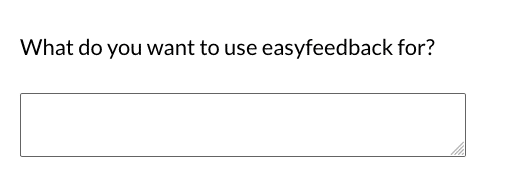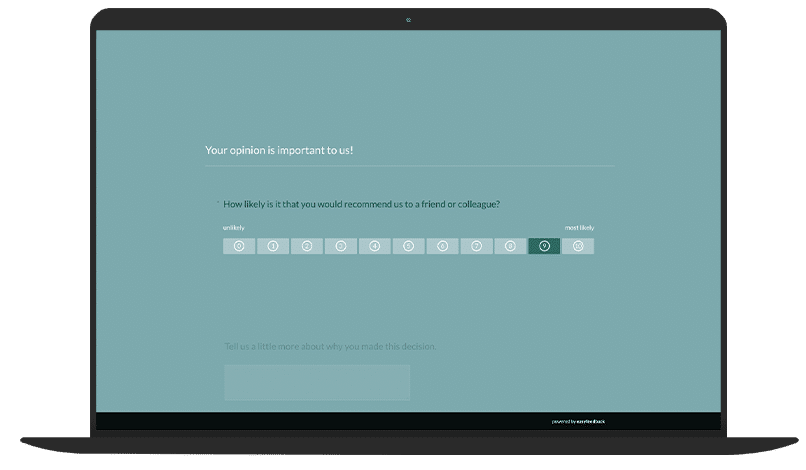Touchpoint 1 – Determine needs before the purchase
Every customer and every prospective customer goes through a series of touchpoints with the company during the initiation phase.
This usually begins completely outside our sphere of influence, when it takes place via word of mouth, or within our sphere of influence, when we start with out-of-home campaigns, TV campaigns or similar.
It is often not yet possible to obtain direct feedback or measure the experience at these points.
You only have the opportunity to interact with the user or prospective customer when they come to your website.
At this point, you don’t yet have any user or email data, which is why Dennis recommends anchoring the first touchpoint on the website.
A good option is to include a survey on the website that opens via a pop-up or modal.
The survey itself is about determining the customer’s needs.
The following sample questions can be used to get to know the prospective customer and their intentions better: What brought you to our website? What are you interested in? What exactly are you looking for? Do you like the content you see?
This is also a good starting point for measuring the effectiveness of marketing measures, checking the quality of your own website and adjusting it if necessary.

Touchpoint 2 – After the purchase
According to Dennis’ recommendation, the second cash flow relevant touchpoint should be queried directly after the purchase.
You should now have the contact details and other information about the customer so that you can interact with them more intensively.
By this time, the customer has already gone through several steps within your company; from the quotation to the payment process to possible support requests.
So you have the opportunity to analyze the steps they went through along the customer journey and ask the new customer what went well and if there were any weaknesses or complications.
This could reveal that there were some hurdles, for example, in the support request or in the payment process.
These are subtleties that you would not otherwise find out about and which you can now work on more thanks to the tip.
What also comes in handy here: Ask your customers about their goals and what they want to use your product for.
On the one hand, this gives you the opportunity to build stronger customer loyalty, and on the other hand, it gives you the opportunity to adapt your marketing measures and develop use cases.

Touchpoint 3 – After the customer’s termination
The third relevant touchpoint, from Dennis’ experience, should be analyzed directly after the termination.
This is basically not a pleasant situation, as it is always very upsetting to lose a customer.
But there are reasons for his cancellation. And asking about them offers you enormous added value, because it gives you the opportunity to improve or adapt your offer.
With an NPS query, this can be implemented excellently.

As a further tip, Dennis recommends going one step further and asking your customers whether they have achieved their goals.
This way, you learn a bit more about their needs and have the opportunity to identify potential disruptive factors for customer satisfaction.
For example, in the case of an online store, there is usually no cancellation.
In this case, it’s interesting to ask the customer after a reasonable period of time why they don’t buy from you again.
- What is the reason for no follow-up purchase?
- Is it the price, the delivery conditions or something else entirely?
Again, this will provide you with important starting points that you can use to improve your products or services.

Summary
With this video, you’ve learned how to gather valuable feedback at three different points in the customer journey to keep prospects and customers engaged and build a positive bond between them and your business.
Targeted surveys offer you the best opportunity to find out whether the individual steps within the customer journey, starting with the search for information and continuing through the purchase and all subsequent positions, are proceeding positively.
This gives you the chance to derive suitable measures, improve your processes and focus on what the customer wants. In this way, you will be able to retain customers in the long term, build up a sustainable business and participate successfully in the market.
Since every company and its structures are different, it may well be that other touchpoints prove useful for you.
Use the touchpoints selected by Dennis as inspiration and simply adapt them to the relevant contact points of your business field.
More about Customer Experience
- Creating positive customer experiences with customer experience management
- Everything you need to know about Customer Experience (CX)!
- Your way to an effective customer experience strategy!
- 10 methods to analyze the customer experience
- 12 practical examples for improving the customer experience
- 10 metrics to measure Customer Experience
- Everything you need to know about the Net Promotor Score (NPS)!
- Customer Satisfaction Score (CSAT) – Measuring Customer Satisfaction differently
- Customer Effort Score (CES): How much effort do your customers have?


